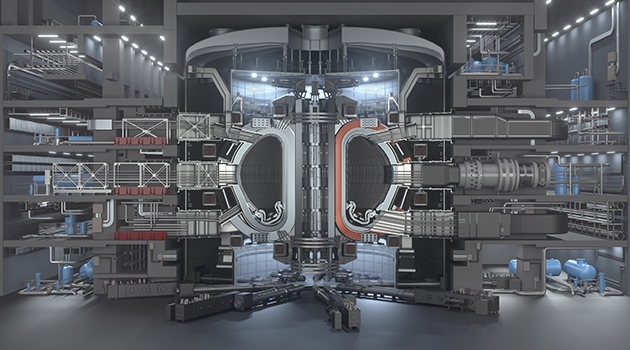Nuclear fusion may provide tomorrow’s safe and cheap energy
Imagine cheap nuclear power without any long-lived radioactive nuclear waste or greenhouse gas emissions. Fusion has been described as the solution to our future energy needs. The problem is that fusion reactions are difficult to achieve; however, earlier this year researchers presented highly promising results that have convinced them that they are on the right track.
“Fusion is the process through which the sun creates energy, so one understands that extreme conditions are required,” says Professor Göran Ericsson of the Department of Physics and Astronomy.
Unlike the reaction that occurs in a normal nuclear power plant, where heavy nuclei are split to release energy, fusion is based on fusing the nuclei of light elements, especially hydrogen, the most common element in the universe and the source of the sun’s power. When two nuclei fuse, the total mass of the resulting single nucleus is less than the mass of the two original nuclei. The reaction converts the leftover mass into energy, and we are talking about a great deal of energy. Just as in the fission reactions in today’s nuclear power plants, every reaction releases around a million times the energy produced by the chemical reaction when we burn something such as wood.
“Fission has a number of advantages over current nuclear power: no long-lived radioactive nuclear waste is generated by the reaction process itself and there is no possibility of an escalating chain reaction that might cause a meltdown or explosion. The raw material used for fuel is also relatively cheap and widespread around the Earth,” explains Ericsson.
Experiments since the 1950s
Thus far, despite experiments dating back to the 1950s, researchers have not succeeded in sustaining a reaction that generates more energy than was used to achieve it. However, following an upgrade to the tiles on the inner reactor wall and recalibration of instruments, the largest operational experimental fission reactor in the world, the Joint European Torus (JET), recently set a new fusion energy record. In the most successful experiment, during the 5 to 6 seconds that it is technically feasible to run the reactor, it produced 59 megajoules (MJ) of energy – enough to boil 60 pans of water. While this may not sound particularly impressive, and it was equivalent to only half the energy required to sustain the process, it did smash the previous record set in 1997 and, for the researchers, it was a clear signal that they are on the right track and will achieve the goal once the next-generation experimental reactor is operational in 2025.
“ITER is currently under construction in southern France and it will have approximately ten times the fuel volume of JET. The intention is to release at least five times the energy required to sustain a fusion reaction. The JET experiment also provided researchers with significant reassurance that the design of ITER will be able to deliver this,” says Ericsson.
Neutrons under check
Researchers at Uppsala University have been working on various aspects of nuclear fusion for some time now. Among their greatest interests is the neutrons released during the fusion process, which fulfil an important function in helping to sustain the reaction by producing new fuel. The problem is that the neutrons create intense radiation around the reactor when it is in operation and may cause a chain reaction in other elements in the material used to build the reactor, making it crucial to keep them under check.
Physics and Astronomy. Photo: Mikael Wallerstedt
“My own research group leads the field in measuring neutrons during fusion. Several of our advanced measurement systems are installed in the experimental fusion reactors JET and MAST. Our system obtained fine data from both the earlier record-breaking experiment in 1997 and the experiment in autumn 2021. Another group at the department is examining more fundamental aspects of the nuclear reactions that neutrons can cause in the materials the reactor is built from. Yet another group is using ion beam methods from nuclear physics to analyse material samples from various fusion experiments, so we can learn more about how the surface and interior of the materials are affected by the specific conditions around a fusion reactor,” says Ericsson.
Åsa Malmberg
Facilities for fusion research
The Joint European Torus (JET)
The world’s largest experimental facility for fusion research. Completed in 1979 at the Culham Centre for Fusion Energy in the United Kingdom. It is managed as a European collaboration within the Euratom programme.
Mega Ampere Spherical Tokamak (MAST)
MAST was a British fusion experiment conducted from 2000 until 2013. A new version of the facility, MAST Upgrade, opened at the Culham Centre for Fusion Energy in 2020.
International Thermonuclear Experimental Reactor (ITER)
Construction of the next-generation experimental fusion reactor ITER began in 2009 in Cadarche in southern France. The facility is expected to open in 2025. The project is an international collaboration between the 27 EU Member States (including Sweden), China, India, Japan, South Korea, Russia, the United States, Switzerland and the United Kingdom.

